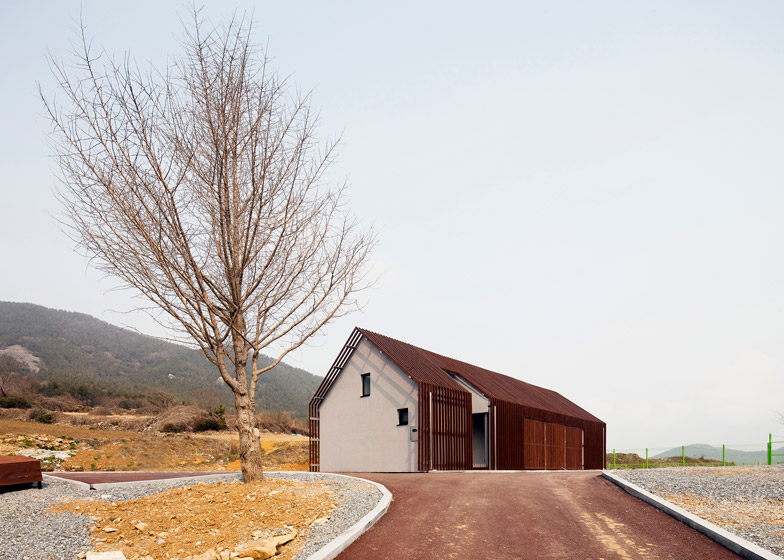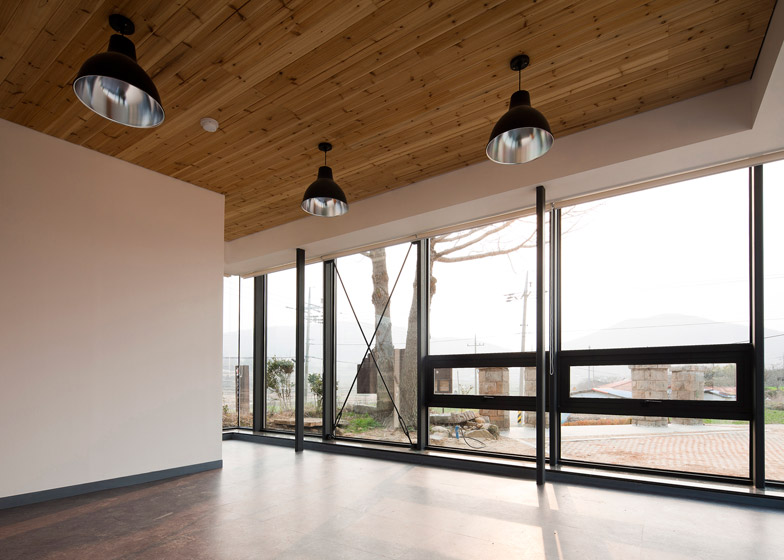A refurbished schoolhouse with a serrated profile forms one of three tourist facilities designed by OUJAE Architects for a remote but scenic island off the coast of South Korea (+ slideshow).
The Cheongsando Slow Island Trip Centre was designed by Seoul-based OUJAE Architects as a visitor complex on the grounds of an old abandoned school.
The complex located on Cheongsando, a small island an hour's boat ride from Wando Port at the south end of the Korean Peninsula. It includes holiday apartments, campsite facilities and a farm shop.
Cheongsando was designated a Slow City in 2009 – a special title given to cities populated by less than 50,000 people, with a strong cultural heritage.
According to the architects, the island's 2,000 inhabitants are spread across 20 villages, and make their living from farming the land rather than the sea due to overfishing.
To enhance island tourism, local authority Wando County commissioned the architects to undertake the project as part of a wider redevelopment that has also provided the island with a community centre, a gallery and an artist's residence.
"The project to refurbish Cheongsando went slowly, avoiding the establishment of artificial facilities marring the beautiful isolated scenery of the island, and preserving it as is," said the architects.
"As the catch decreased accordingly, people began to leave the island," the architects said. "However, with its stunning natural landscape and pastoral scenery, it became popular as a filming location and has recently become a tourist island, visited by over 300,000 tourists a year."
The complex comprises three separate buildings. The refurbished schoolhouse, called the Slow Island Trip Centre, provides a tourist information centre and holiday accommodation. There is also a farm produce shop called Slow Food Workshop, and an office annex that provides services for a campsite.
The remodelled Cheongsan Middle School is topped by a row of triangular timber-clad volumes, which form five standalone holiday dwellings with their own private outdoor terraces.
"Slow Island Trip Centre – the main building – was originally a two-storey school building," explained studio architect Choi Kyosik. "The second floor had structural problems, so we had to demolish that floor."
"After deciding to demolish the second floor, we designed separate five wooden frame structures on the first floor," he told Dezeen. "The slope of the roof was needed because of rain. So, we designed triangular roof with an all-wooden exterior."
The structure is stabilised by a steel frame and concrete pillars, while the pyramidal pods are constructed and clad in cedar wood. Local granite was used to clad the ground floor.
"Cheongsando has a tradition of building stone walls," said the architects. "The use of stone walls were a small thing, yet provided a way for the local residents to participate in the construction process. In this project, the residents personally worked on the outer wall construction in the traditional method of filling the walls with red clay."
The Slow Food Workshop, which makes and sells local produce including fermented soybeans, is set in a white-gabled building with an asphalt shingle roof. The whole structure is covered in a frame of timber louvres and a glazed entrance is recessed into an opening at one of the long facades.
The final structure is a single-storey building with an inverted pitched roof. It provides administrative offices and shower facilities for a campsite intended to occupy the old playground.
The glazed structure is fronted by a wide stone deck that allows the building to be accessed from all directions from the campsite. Panels of frosted glass in the facade are designed to provide privacy for the shower cubicles and toilets within.
"Considering that the building will contain showers and restrooms, this envelope does not really suit the character of the program," said the architects, describing the impracticality of the glazed facade. "Nonetheless, the glass envelope was selected to reinforce functionality while differentiating the structure from the main building."
"Along with etching film and LED lighting, the glass with its transparent physical property acts as a small lighthouse lighting the entire playground in the lonely aftermath of sunset," they added.
The Cheongsan project was completed in 2012. It was exhibited as part of the Out of the Ordinary: Award Winning Works by the Young Korean Architects show, which ran at London Metropolitan University's The Cass earlier this year.






















